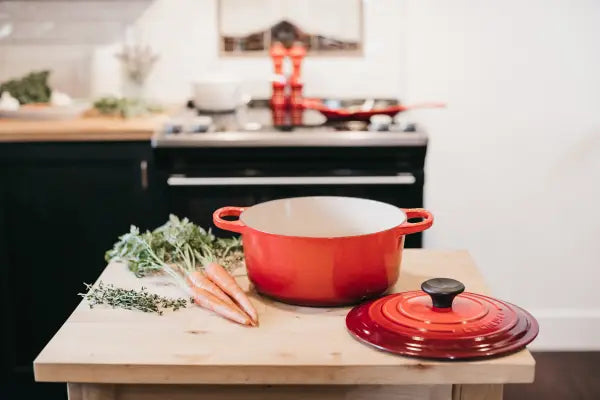Chew, Squish, Smush: Why Texture Matters - Whether You're Pureeing or Doing Baby-Led Weaning
Starting solids? Here is why texture deserves your attention
Introducing solids is a fun and significant milestone in your baby’s development! It marks their transition from an all-liquid diet of breastmilk or formula to a new world filled with many different flavors, colors, and, importantly, textures.
While most parents (appropriately) think a lot about what foods to introduce first to their little one in terms of nutrition (make sure to check out our recommendations here). It's also essential to think about the sensory aspects of how foods feel. This applies whether you’re starting with spoon-fed purees, baby-led weaning, or somewhere in between.
Let's explore why texture variety matters when starting solids, its impact on a little one’s eating, and some creative ways to introduce new textures and flavors.
Why is texture important in self-feeding?
How does sensory play support feeding and development?
Foods provide us with so much sensory stimulation! Think about the input your body receives via sight, touch, sound, taste, and smell with any food you eat. And by “self-feeding,” we also mean all the little steps where babies interact with food, whether that’s with a spoon or their fingers. Now, mash that banana up with a fork! Now, bake it into a muffin mix! So many different sensory experiences with just one food!
Foods provide us with so much sensory stimulation! Think about the input your body receives via:
-
Sight: Colors and shapes spark curiosity.
-
Touch: Squish, smear, and smash are part of learning.
-
Sound: Crunchy vs. soft textures stimulate attention.
-
Taste: New flavors encourage exploration and preference development.
-
Smell: Aromas guide curiosity and prepare the body for digestion.
For adults, we may not give it much thought, but for babies, this sensory input is how they explore and learn about their world. A variety of textures provides your baby with more stimulation and, therefore, learning opportunities for your baby.

What does chewing teach babies during weaning?
Not only do different textures help with sensory development, but they also help with your little one’s oral motor development.
When babies start solids, they are learning how to manage food in their mouth and chew.
By giving them a variety to eat, they have more opportunities to learn how to:
-
Manipulate different foods with their tongues
-
Use gum ridges or teeth
-
Engage their jaw with different motions and strength to break down various types of food
Research backs this up! There is evidence that chewing improves through texture exposure and can even lead to children preferring to eat harder textures later on.
Regardless of what weaning approach you initially pick, that is why we recommend all babies be exposed to finger foods by 9 months of age, because babies show the biggest changes in their feeding behaviors and chewing between 8 and 10 months (check out the research here!).
Can texture exposure reduce picky eating later on?
So now we have discovered the importance of texture variety for sensory stimulation and chewing development… but is there even more? Absolutely — picky eating prevention!
In the first year of life, children are naturally more receptive to:
-
New food flavors
-
New food textures
It is developmentally normal for pickiness to increase as they get older, so let’s take advantage of their openness while we can!
As with most things in life, the earlier you start doing something or practicing it, the easier it is later on, and the same goes for food. The earlier you introduce variety to your child, the less likely they are to be sensitive to it later on. Whether they’re tasting smooth purees or nibbling on soft solids, the variety in texture helps them build confidence.
Example:
If your child has been playing with sticky, lumpy mashed bananas since they were 6 months, fewer internal alarm bells are going to go off when they are offered it again at 12 months old.
What are the best weaning methods to introduce texture?
How to add texture variety when using purees
At Bebe Foodie, we really want you to pick the weaning approach that works best for your family. Whether that means you are starting with only purees, using baby-led weaning, or a combination approach of the two - you can use this information to help your child.
If you want to focus on only purees at first, make sure to give your child exposure to different textures by:
-
Frequently offering new foods
-
Combining foods for more variety in color, smell, and taste
-
Varying how finely you “puree” the food
-
Try a thicker consistency some days
-
Using just a fork to mash very soft foods so your baby experiences soft chunks
-
Utilize naturally different types of purees, such as cottage cheese, mashed potatoes, and stage 1 store-bought purees
Just be mindful of choking risks — make sure any pieces are appropriately sized and soft. Do you want to make your own purees? It’s super easy and will give you control over how thick or textured you make the purees. Learn how!

What are examples of textured meals for baby led weaning?
If you are doing baby-led weaning, offer a variety of food from the start.
You can even include a variety of textures within one meal, like:
-
Pancakes with a side of a soft, large, whole strawberry
-
Yogurt with mashed berries mixed in
-
Sweet potatoes alongside soft, cooked vegetable pieces
This encourages babies to experiment with how different foods feel and how to manage them in the mouth — a core goal of baby-led weaning.
Tips from a feeding therapist on infant-led feeding
1. Should Babies Get Messy While Learning to Eat?
Let Them Get Messy!
Don’t forget that the sensory experience happens across a child’s whole body, too!
I know… your eye is probably twitching reading that (I’m sorry!). Try not to wipe your little one’s hands or face frequently during the meal — let them learn to get comfortable with the different sensations!
That said, you don’t have to embrace full chaos at every meal. Pick the moments that feel right for you, on bath nights, or when you're in the mindset for a little extra cleanup.
This isn’t about perfection or always doing things one way, it’s about gradually helping your baby feel more comfortable, in a way that works for your family.
Here are a few practical tips:
-
- Dress your baby in a bib with good coverage or use a washable smock-style top to make cleanup easier.
- Plan to serve your messiest foods when you have a bit more time, or right before bath time if it helps.
-
Keep a damp washcloth nearby for a gentle cleanup after the meal (not during!).
-
Most importantly: follow your own rhythm. Some days you’ll be up for messy play, and some days you won’t, and that’s perfectly okay.
2. How long does it take for babies to accept new textures?
Be patient with texture acceptance
It can take multiple exposures to a new texture for a baby to accept it.
If your baby seems to be struggling with a certain texture after multiple opportunities to eat it, they may need more time to develop their oral motor skills, it's okay to take a brief break and then try again after some more eating practice with other textures.
Always reach out to your pediatrician or feeding therapist with questions!
3. How can I make mealtimes more fun and less stressful?
Focus on fun, not perfection
Always remember to focus on mealtime fun. Remember: low pressure!
You can help your child feel more comfortable by:
-
-
Modeling interaction with new foods
-
Getting messy with them
-
Eating the food alongside them
-
Babies learn best through observation and play.

Baby-led weaning and a lifetime of Confident Eating
We now know that exposing babies to different textures when starting solids is a crucial step in their developmental journey.
It supports:
-
Sensory development
-
Oral motor skills
-
Reduced picky eating tendencies
By introducing a variety of food consistencies and allowing babies to explore them at their own pace, parents can help set the foundation for a lifetime of healthy eating habits. But remember, it’s not about doing things one perfect way. Confidence comes from a mix of practice, exposure, and following your baby’s pace. So, embrace the mess (when you’re up for it!), explore, and enjoy the wonderful world of food textures, one bite, squish, or smush at a time!
Want help putting texture variety into practice? The Bébé Foodie app gives you daily food suggestions with ideas on how to serve them, whether mashed, pureed, or finger food, plus recipes, tips, and expert guidance to support your baby's food journey, your way.

Written by Lauren Remondino, MS, CCC-SLP, CLC
Feeding Therapist, Speech Language Pathologist, Lactation Counselor & Advisor at Bébé Foodie
Lauren Remondino is a pediatric feeding specialist and mom, with a background in speech-language pathology and lactation counseling. After years working in top children’s hospitals, she now brings her clinical expertise—and real-life parenting perspective—to Bébé Foodie. Lauren works closely on developing our How to Serve guides and feeding support content, helping parents feel confident at every stage of their baby’s food journey. She’s all about keeping things realistic, flexible, and supportive—because feeding isn’t one-size-fits-all, especially when you’re juggling nap schedules and snack requests.
This blog post is for information purposes only and shouldn’t be used as personal, health, nutritional, or medical advice. Always consult with your pediatrician before making any decisions about your child's health or readiness for various foods.




Leave a comment